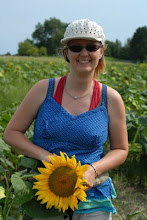With the three week stay of my sister last recently I decided it was high time to learn the ins and outs of soap making as she makes and sells artisan soaps at renaissance fairs for years now. No better way to learn than from an expert I think :)
And I must say, now I know what to look for and what to look out for, soap making is not as difficult as I worried - sort of like making custard with rubber gloves and a ski mask - and definitely a heck of a lot more addictive than I anticipated! Which kinda means that if I'm not gonna sell any bars anytime soon, we'll have plenty of soap for us and any birthday presents until the end of times LOL.
So, what did I learn?Lye goes in, but does not come out, so to say: soap making is a chemical process which means the fats/oils plus lye equals soap and the process is called saponification.
Wear protective clothing, gloves and goggles - until the chemical process is complete the soap soup is caustic and can burn holes in what you wear and you!
Go slow, do not hurry; no distraction from kids, cats or husbands allowed.
Wait 24 hours before cleaning, most will be saponified and suds up, plus it's not as caustic.
Oh, and if you have a septic system, wipe all chunks off first and discard in the trash - no sense in blocking up the pipes with "undigested" soap traces!
Don't handle uncured soap with bare hands, we have to wait the 6-8 weeks as well.
Before doing any actual work have someone walk you thru the process, either "live" or by reading lots of books with color pictures and watching a dvd or two. You'll need to learn what to "look" for before mixing any hazardous chemicals on your own.
About that last, have a gallon jug of vinegar on hand to neutralize any caustic spills if needed.
My sister taught me well :)
What materials seem to work for me?a large 7qt crock pot
a digital scale
2 candy thermometers
a large (narrow) measuring beaker (to add lye crystals to water)
a medium measuring beaker (to weight water in)
a small measuring beaker (for lye)
several metal stirring spoons (full and slotted)
several rubber spoons to remove the last bits
several molds
rubber gloves
large safety glasses (wrap around kind)
an electric grater to hand mill / rebatch
a small band saw to cut hardened soap.
I already had the large crockpot (bought on sale at Wegmans) for making apple butters and most of the beakers from our dark room - a bunch of the other stuff I got at the Salvation Army store and Dollar Stores around town. The scale I got at Bed, Bath & Beyond (wait for the coupons) and the large beaker at Maine's restaurant supply.
You can use pretty much anything as a mold, though you might have to line it (wax paper) and/or freeze it to get the bar out. I prefer partially flexible plastic molds that don't need to be lined and most of the time the bar comes out of fairly easily. Ikea has good food grade plastic storage containers (with lid), kitchen stores carry flexible silicone molds like square cake pans or muffin pans and dollar stores tend to carry drawer dividers - all useful soap molds. Same for empty milk containers (waxed cardboard), pringle tubes, novelty cake pans, oatmeal containers, pvc piping...
Interesting books:Soap Makers Workshop by Mc Daniel.
My definite favorite how-to book, comes with instructional DVD. Great pics, great recipes, geared towards people who'd like to start a soap making business.
Handmade Soap by Country Living.
Not really a how-to, but loads of good recipes and ideas.
The Soapmaker's Companion by Cavitch.
Lots of recipes, techniques and know-how (learn to design & calculate your own recipes).
The Natural Soap Book by Cavitch.
A great basic guide for herbal and vegetable based soaps.
All available thru Amazon.
Interesting websites:Miller's Home Made Soap Pages
www.millersoap.comMajestic Mountain Sage (has a lye calculator)
www.thesage.com
When I feel like typing again, I'll add some of the recipes I made the past month!
The olive oil only soap smells wonderful (and no added fragrance whatsoever!) and the oatmeal and honey soap smells like cookies... I still think it's funny, though, when cleaning my soap making stuff the stuff to clean off is soap, that'll suds up and clean itself :)
 After finding that picture on the web at WorkingGoats.com I knew for sure, this is the year I'm gonna try to train one of our goats to pull! We have that same green metal garden cart, and man, is it a chore on my joints getting it back uphill (even tho it's empty most of the time)... Hopefully we'll have a buck, or two to choose from from our first group of goat kids and I can start training from scratch. It'll be a while before I'll have help pulling the cart; definitely not this year, maybe next - but I am already looking forward to having help moving the chicken manure, goat manure, wood and weeds :)
After finding that picture on the web at WorkingGoats.com I knew for sure, this is the year I'm gonna try to train one of our goats to pull! We have that same green metal garden cart, and man, is it a chore on my joints getting it back uphill (even tho it's empty most of the time)... Hopefully we'll have a buck, or two to choose from from our first group of goat kids and I can start training from scratch. It'll be a while before I'll have help pulling the cart; definitely not this year, maybe next - but I am already looking forward to having help moving the chicken manure, goat manure, wood and weeds :)









